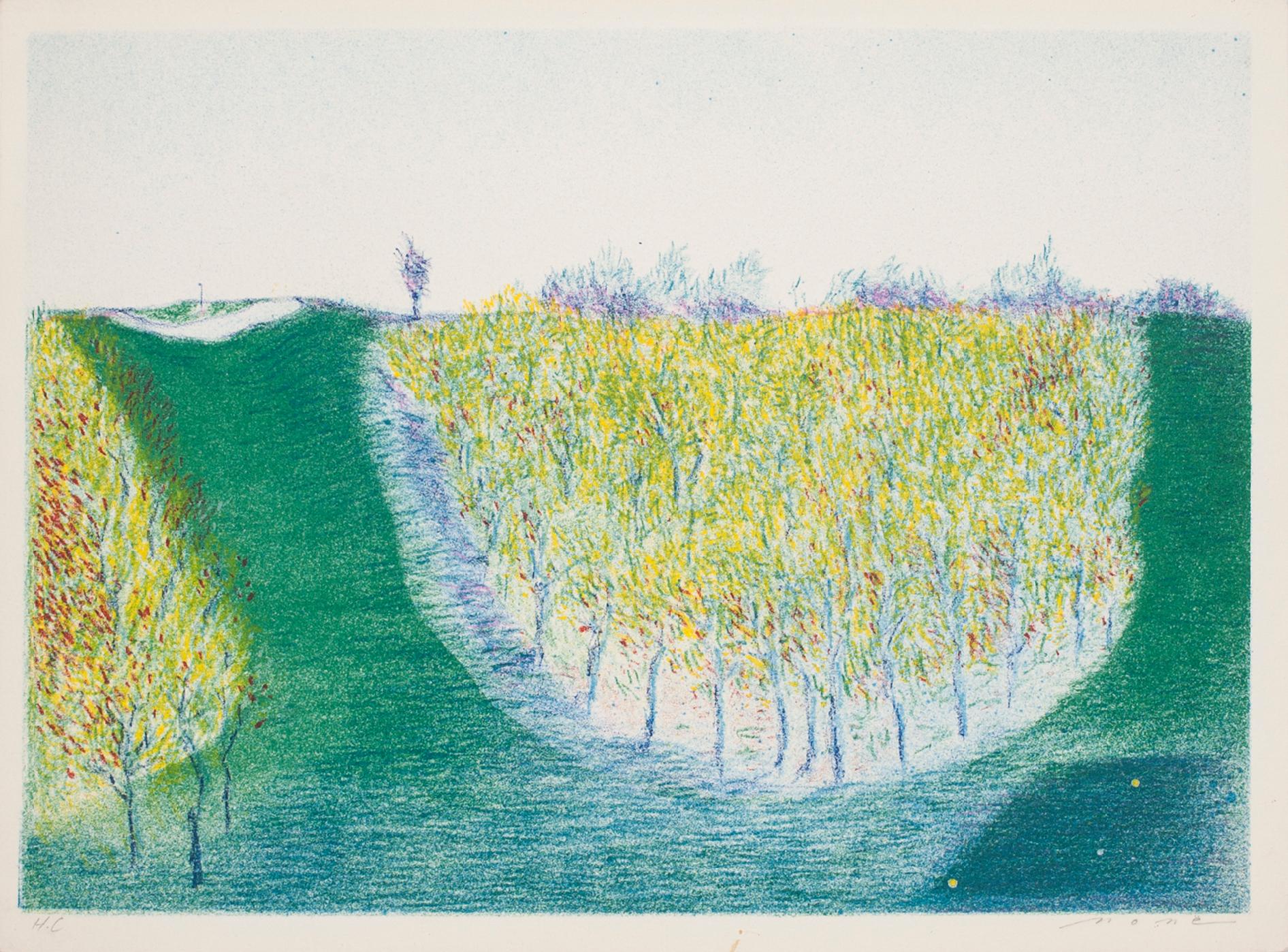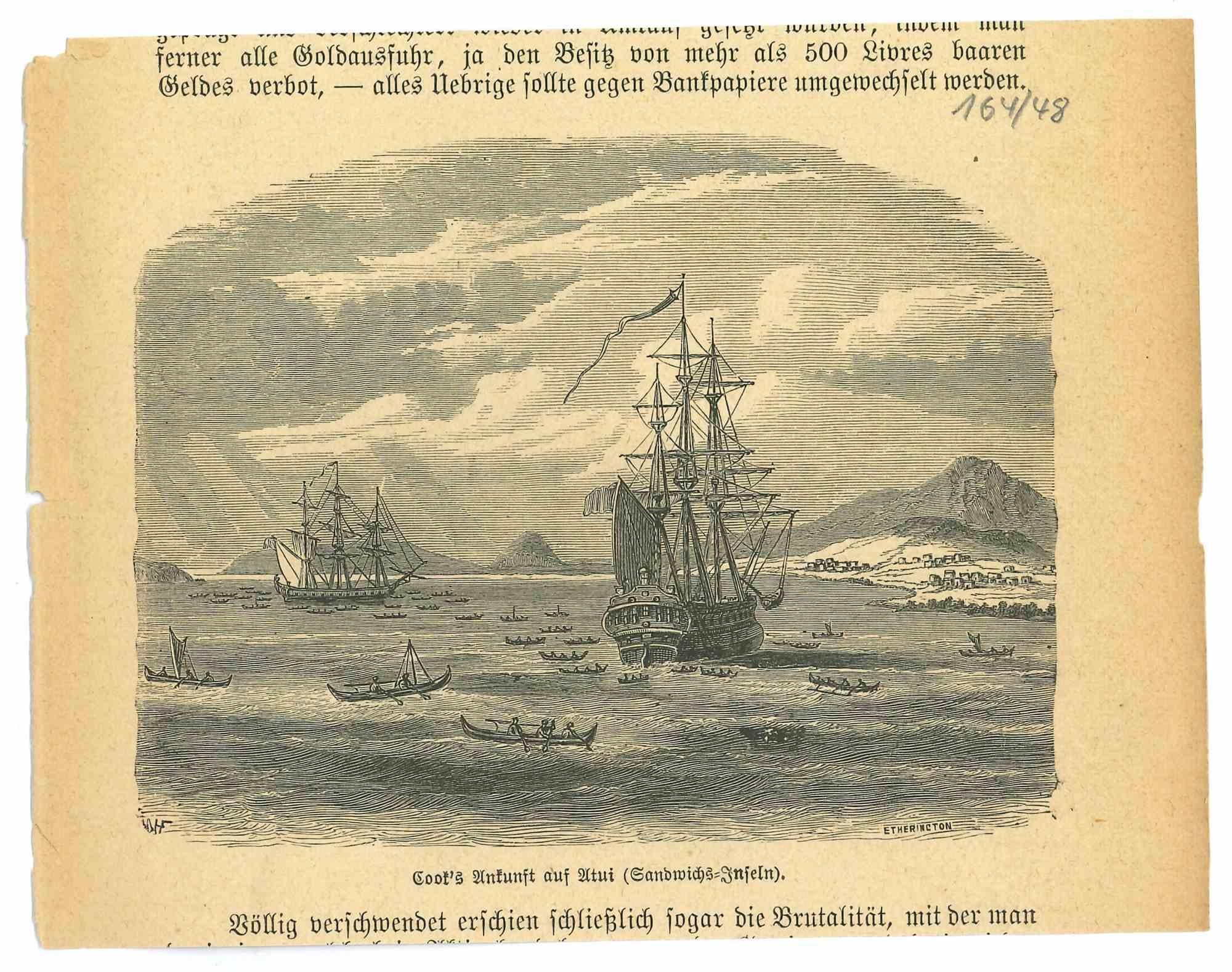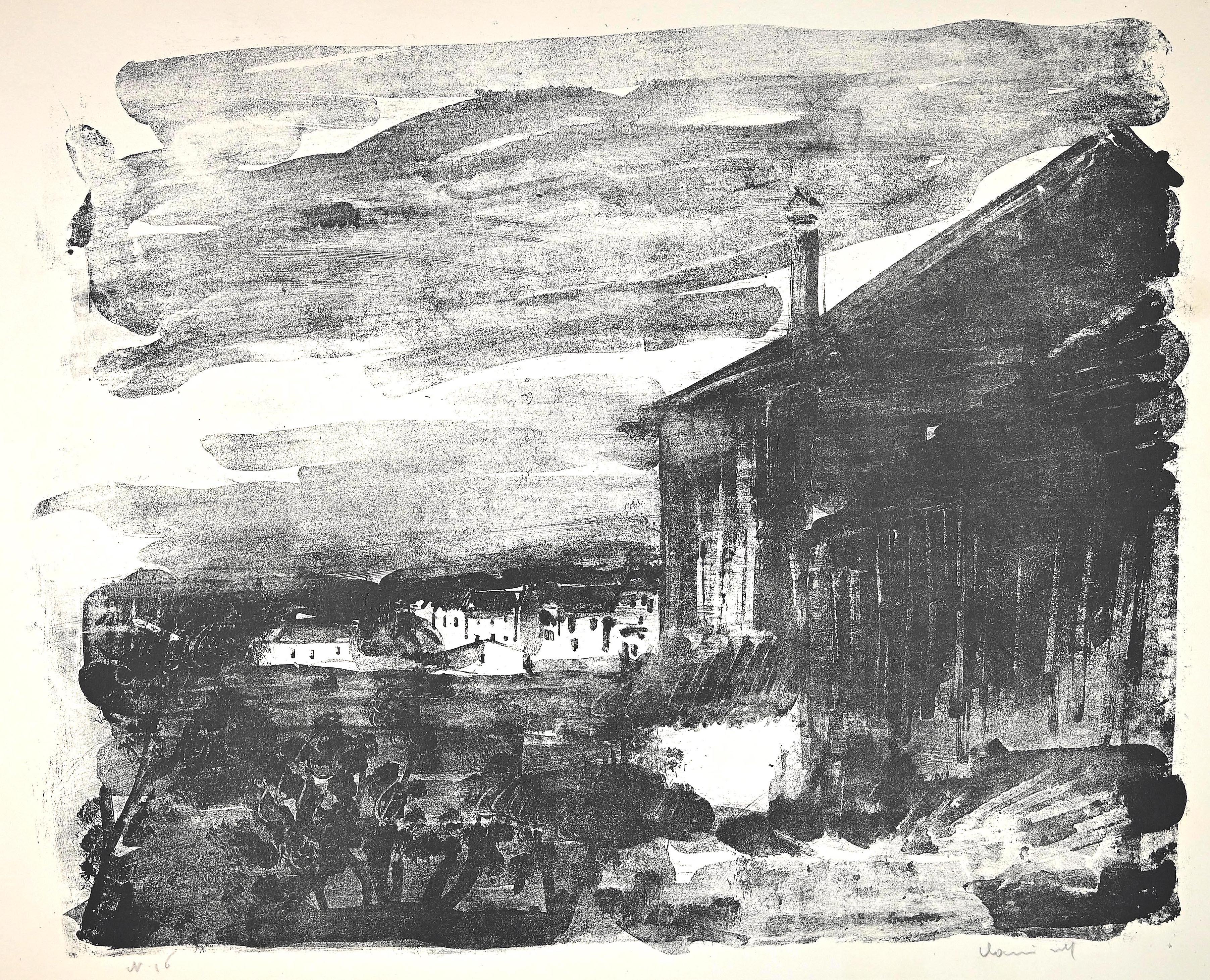George Grosz1936 Lithograph Soldiers in battle World War I small edition1936
1936
About the Item
- Creator:George Grosz (1891-1969, German)
- Creation Year:1936
- Dimensions:Height: 15.75 in (40 cm)Width: 11.42 in (29 cm)
- Medium:
- Period:
- Condition:good, minor edge wear.
- Gallery Location:Surfside, FL
- Reference Number:1stDibs: LU38210449612
George Grosz
George Grosz was a German artist known especially for his caricatural drawings and paintings of Berlin life in the 1920s. He was a prominent member of the Berlin Dada and New Objectivity group during the Weimar Republic. Grosz studied drawing at the Dresden Academy (1909–11) and at the School of Arts and Crafts in Berlin (1912–14). He was in the army from 1914–15, and again for a short time in 1917, but spent the rest of the war in Berlin, where he made violently anti-war drawings, in which his main focus was attacking the social corruption of Germany (capitalists, prostitutes, the Prussian military caste, the middle class). His artworks had great impact in the Berlin Dada movement, 1917–20, and collaborated with John Heartfield and Raoul Hausmann in the invention of photomontage.
Many of Grosz’s drawings were published in albums (Gott mit uns, Ecce Homo, Der Spiesser-Spiegel, etc.), and he was subject to prosecutions for insulting the army and blasphemy. He visited the United States in 1932 to teach at the Art Students League, New York, and settled there in 1933. In the latter part of his career, he tried to establish himself as a pure painter of landscapes and still life, but also painted many compositions of an apocalyptic and deeply pessimistic kind. His role in the Berlin Dada movement affected political outlooks and artistic developments not only in Germany, but also in Russia, the Balkan nations, and parts of France.
Grosz's penetrating, darkly humorous style of drawing and his use of satire as a weapon left a deep impression on the work of his contemporaries and the artists of the next generation. Some of his works from the early 1940s, particularly during World War II, do present an allegorical and dramatic representation of Grosz's moral perspective regarding war. Additionally, some of his last pieces from 1958 were photomontages, and hearken back to his earlier Dadaist aesthetic and message, passing judgment upon consumerism and suggesting that his absorption with American culture had ended in disappointment. In 1959, Grosz sold his house and moved back to Berlin. He died shortly after his return, after a fall down the stairs.
- ShippingRetrieving quote...Ships From: Surfside, FL
- Return PolicyA return for this item may be initiated within 3 days of delivery.
- Japanese Woodblock Artist French Lithograph Fauvist Colors School of ParisBy Shungo SekiguchiLocated in Surfside, FLShungo Sekiguchi, (Japanese, 1911-2002): Lithograph in color on Rives paper Hand signed in pencil lower right, hand numbered It appears to be the village of Montmarte in Paris This was published by the Guilde de la Gravure, Paris, France and bears their GG blindstamp. They were a mid century French art publisher and published many masters including Raoul Dufy, Max Erns, Jean Hans Arp, Ruffino Tamayo, Balthus, Gino Severini and Leonard Tsuguharu Foujita. Shungo Sekiguchi was born 1911 in Japan. In 1932 Shungo Sekiguchi contributed to the print series "One Hundred Views of Great Tokyo" (Dai Tokyo hyakkei). Prints from watercolors published by Kaneda Shoten (Nihon Hanga Ken-kyusho). In 1935, Sekiguchi moved to Paris, France to study at the prestigious Ecole des Beaux Art of France with a scholarship of the French government. He studied together with two other Ecole de Paris Japanese artists, Takanori Ogisu and Tsuguji Foujita. He exhibited at the prestigious "Salon d'Automne" in Paris. In 1940 when Paris was occupied by the German Nazis, Shungo Sekiguchi returned to Japan, but kept his ties with France. In 1952 he exhibited at the famous Salon d'Automne and received an award. In 1959, he received an award at the Vicci International Art Contest. In 1964, he received the Diplome d'Honneur des at Jobiji International Art Show. His retrospective exhibition has been held in many places in Japan. In 2002 the artist died in Japan. He is popular in Japan and several retrospective exhibitions were held in Japan. He was part of the Shin Hanga and Sosaku Hanga woodblock artists known for their woodcut prints and scrolls. Shin-hanga was an art movement in early 20th-century Japan, during the Taisho and Showa periods, that revitalized traditional ukiyo-e art rooted in the Edo and Meiji periods. He also worked as a book illustrator and did the artwork for the French edition of Le démon doré by Ozaki Kohyo. He is included in Helen Merritt and Nanako Yamada's classic book "Guide to Modern Japanese Woodblock...Category
1950s Post-Impressionist Landscape Prints
MaterialsLithograph
- Surrealist Dream Lithograph Belgian Master Magritte Pencil Signed by MourlotBy René MagritteLocated in Surfside, FLArtist: Rene Magritte (after), Belgian (1898 - 1967) Title: (from les Enfants Trouvés) Les Claires-Voies d'un Jeune Regard Embaument La Fête d'un V...Category
1960s Surrealist Landscape Prints
MaterialsLithograph
- Israeli Folk Art Hebrew Naive Judaica Bible Exodus Lithograph Shalom of SafedBy Shalom MoskovitzLocated in Surfside, FLVintage pencil signed and numbered limited edition lithograph on deckle edged Arches paper. Shalom of Sefad (Shulem der Zeigermacher in Yiddish Shalom Moskowitz) Shalom of Tzfat lived for over seventeen years in his native town of Safed in the hills of the Galilee. There he worked as a watchmaker, stonemason and silversmith, during the 50's. Since then this self-taught artist has achieved an international reputation. Shalom is a naive painter, but not a primitive one, he expresses a very elaborate way of thinking in his own way. While belonging to Hasidism, Shalom of Safed...Category
20th Century Folk Art Figurative Prints
MaterialsLithograph
- Simka Simkhovitch WPA Artist Lithograph Island Beach 1933 American ModernistBy Simka SimkhovitchLocated in Surfside, FLSimka Simkhovitch (Russian/American 1893 - 1949) signed lithograph. Pencil signed and dated "S. Simkhovitch 1933" lower center. Title "Island Beach," in pencil lower left of sheet. Numbered "44/50" in pencil lower right. (it is either Island Beach Wisconsin or New Jersey) Simka Simkhovitch (Симха Файбусович Симхович) (aka Simka Faibusovich Simkhovich) (Novozybkov, Russia May 21, 1885 O.S./June 2, 1885 N.S.—Greenwich, Connecticut February 25, 1949) was a Ukrainian-Russian Jewish artist and immigrant to the United States. He painted theater scenery in his early career and then had several showings in galleries in New York City. Winning Works Progress Administration (WPA) commissions in the 1930s, he completed murals for the post offices in Jackson, Mississippi and Beaufort, North Carolina. His works are in the permanent collections of the Dallas Museum of Art, the National Museum of American Art and the Whitney Museum of American Art. Born outside Kyiv (Petrograd Ukraine) into a Jewish family who owned a small department store. During a severe case of measles when he was seven, Simcha Simchovitch sketched the views outside his window and decided to become an artist, over his father's objections. Beginning in 1905, he studied at the Grekov Odessa Art School and upon completion of his studies in 1911 received a recommendation to be admitted to the Imperial Academy of Arts. Though he enrolled to begin classes in architecture, painting, and sculpture at the Imperial Academy, he was dropped from the school roster in December because of the quota on the number of Jewish students and drafted into the army. Simchovitch served as a private in the 175th Infantry Regiment Baturyn [ru] until his demobilization in 1912. Re-enrolling in the Imperial Academy, he audited classes. Simka Simkhovitch exhibited paintings and sculptures in 1918 as part of an exhibition of Jewish artists and in 1919 placed 1st in the competition "The Great Russian Revolution" with a painting called "Russian Revolution" which was hung in the State Museum of Revolution. In 1922, Simkha Simkhovitch exhibited at the International Book Fair in Florence (Italian: Fiera Internazionale del Libro di Firenze). In 1924, Simkhovitch came to the United States to make illustrations for Soviet textbooks and decided to immigrate instead. Initially he supported himself by doing commercial art and a few portrait commissions. In 1927, he was hired to paint a screen for a scene in the play "The Command to Love" by Fritz Gottwald and Rudolph Lothar which was playing at the Longacre Theatre on Broadway. Art dealers began clamoring for the screen and Simkhovitch began a career as a screen painter for the theater. Catching the attention of the screenwriter, Ernest Pascal, he worked as an illustrator for Pascal, who then introduced him to gallery owner, Marie Sterner. Simkhovitch's works appeared at the Marie Sterner Gallery beginning with a 1927 exhibit and were repeated the following year. Simkhovitch had an exhibit in 1929 at Sterner's on circus paintings. In 1931, he held a showing of works at the Helen Hackett Gallery, in New York City and later that same year he was one of the featured artists of a special exhibit in San Francisco at the California Palace of the Legion of Honor in Lincoln Park. The exhibit was coordinated by Marie Sterner and included four watercolors, including one titled "Nudes". He is of the generation of Russian Soviet artists such as Isaac Pailes, Serge Charchoune, Marc Chagall, Chana Orloff, Isaac Ilyich Levitan, and Ossip Zadkine. In 1936, Simkhovitch was selected to complete the mural for the WPA Post office project in Jackson, Mississippi. The mural was hung in the post office and courthouse in 1938 depicted a plantation theme. Painted on the wall behind the judge’s bench, “Pursuits of Life in Mississippi”, a depiction of black workers engaged in manual labor amid scenes of white professionals and socialites, was eventually covered over in later years during renovations due to its stereotypical African American imagery. The following year, his painting "Holiday" won praise at an exhibition in Lincoln, Nebraska. In 1940, Simkhovitch's second WPA post office project was completed when four murals, "The Cape Lookout Lighthouse and the Orville W. Mail Boat", "The Wreck of the Crissie Wright", "Sand Ponies" and "Canada Geese" were installed in Beaufort, North Carolina. The works were commissioned in 1938 and did not generate the controversy that the Jackson mural had. The main mural is "The Wreck of the Crissie Wright" and depicts a shipwreck which had occurred in Beaufort in 1866. "The Cape Lookout Lighthouse and the Orville W. Mail Boat" depicted the lighthouse built in 1859 and the mail boat that was running mail during the time which Simkhovitch was there. The boat ran mail for the area until 1957. "Sand Ponies" shows the wild horses common to the North Carolina barrier islands and "Canada Geese" showed the importance of hunting and fishing in the area. All four murals were restored in the 1990s by Elisabeth Speight, daughter of two other WPA muralists, Francis Speight...Category
1930s American Modern Landscape Prints
MaterialsLithograph
- Israeli Folk Art Hebrew Naive Judaica Lithograph Jewish Holiday ShavuotBy Shalom MoskovitzLocated in Surfside, FLVintage pencil signed and numbered limited edition lithograph on deckle edged Arches paper. Shalom of Sefad (Shulem der Zeigermacher in Yiddish Shalom Moskowitz) Shalom of Tzfat lived for over seventeen years in his native town of Safed in the hills of the Galilee. There he worked as a watchmaker, stonemason and silversmith, during the 50's. Since then this self-taught artist has achieved an international reputation. Shalom is a naive painter, but not a primitive one, he expresses a very elaborate way of thinking in his own way. While belonging to Hasidism, Shalom of Safed uses his artistic talents positively. 'I don't paint', he explains, 'to tell the story of the Bible in color and lines. His works have been exhibited in prominent museums and galleries in Europe and the United States, and are included in the collections of the Museums of Modern Art in Paris and New York, the Israel Museum in Jerusalem, the Stedelijk Museum in Amsterdam, the Modern Museum in Stockholm and the Jewish Museum in New York He has exhibited alongside all of the Israeli great artists. Israel has had a Vibrant Folk Art, Naive art scene for a long time now artists like Yisrael Paldi, Nahum Guttman, Reuven Rubin and even Yefim Ladizhinsky had naive periods. The most well know if the strict naive artists are Shalom of Safed, Irene Awret...Category
20th Century Folk Art Figurative Prints
MaterialsLithograph
- 1970 Silencio, Direccion Unica, One Way Spanish Political Etching Pop Art PrintBy Juan GenovesLocated in Surfside, FLJuan Genovés Candel (Spanish, 1930-) Painter, illustrator, and graphic printmaker engraver. He painted 'El abrazo' ('the embrace'), which became an emblematic poster during the Spanish political transition. He was born in Valencia in 1930. The son of Juan Genovés Cubells, an artisan whose family was close to the labor movement. His mother Maria Candel Muñoz came from a family of practicing Catholics. In 1946 Genovés studied at the Escuela de Bellas Artes de San Carlos in Valencia and then settled in Madrid. He set up the 'Los Siete' group together with other artists in 1949, and the following year he travelled to Madrid, where he was influenced by the works by Fra Angélico and Hieronymus Bosch in the Prado Museum. In 1957 he had his first solo exhibitions in the gallery Alfil, Madrid and in the Museo d'Arte Moderna, Havana. He is considered the most important representative of modern Spanish painting. His images, executed in a politically engaged, critical realism...Category
1970s Pop Art Figurative Prints
MaterialsLithograph
- Interieur de Geneve. L'Hopital - Lithograph by Antonio Fontanesi - 1854By Antonio FontanesiLocated in Roma, ITThis splendid lithograph Interieur de Geneve. L'Hospital is part of the series of 20 prints dedicated to views of the city of Geneva, engraved by the Italian artist Antonio Fontanesi...Category
1850s Old Masters Landscape Prints
MaterialsLithograph
- Landscape - Lithograph - 20th centuryLocated in Roma, ITImage dimensions: 26x36 cm. Landscape is a beautiful artwork realized by an artist of the 20th century. Litoghaph. In very good condition. Signed on the lower margins; on the left 'H.C.' on the right 'none'. This realistic drawing...Category
20th Century Figurative Prints
MaterialsLithograph
- View of Berat - Original Lithograph - 19th CenturyLocated in Roma, ITView of Berat is an original ithograph realized by an unknown artist of 19th century. The little artwork is in good condition except for some stains and some small tears on the marg...Category
19th Century Modern Figurative Prints
MaterialsLithograph
- Air Project - Lithograph on Cardboard - 20th CenturyLocated in Roma, ITAir project is a lithograph on cardboard realized by an Unknown artist of the 20th Century. The State of preservation is good. Sheet dimension: 38.5 x 28.5 The artwork represent...Category
20th Century Modern Figurative Prints
MaterialsLithograph
- Gandwichs - Original Lithograph - Mid 19th CenturyLocated in Roma, ITGandwichs is an original modern artwork realized in Germany in the Mid-19th Century. Original B/W Lithograph on Ivory Paper. Inscripted on the lower central margin in Capital Lett...Category
Mid-19th Century Modern Landscape Prints
MaterialsLithograph
- Environs de Triel - Lithograph by Maurice de Vlaminck - 1920sBy Maurice de VlaminckLocated in Roma, ITFine print on vélin fort “Arches”, numbered and signed in pencil by the artist. Small stain on right margin of the sheet. Light oxidation on bottom right angle. Full margins. Ref...Category
1920s Modern Landscape Prints
MaterialsLithograph






